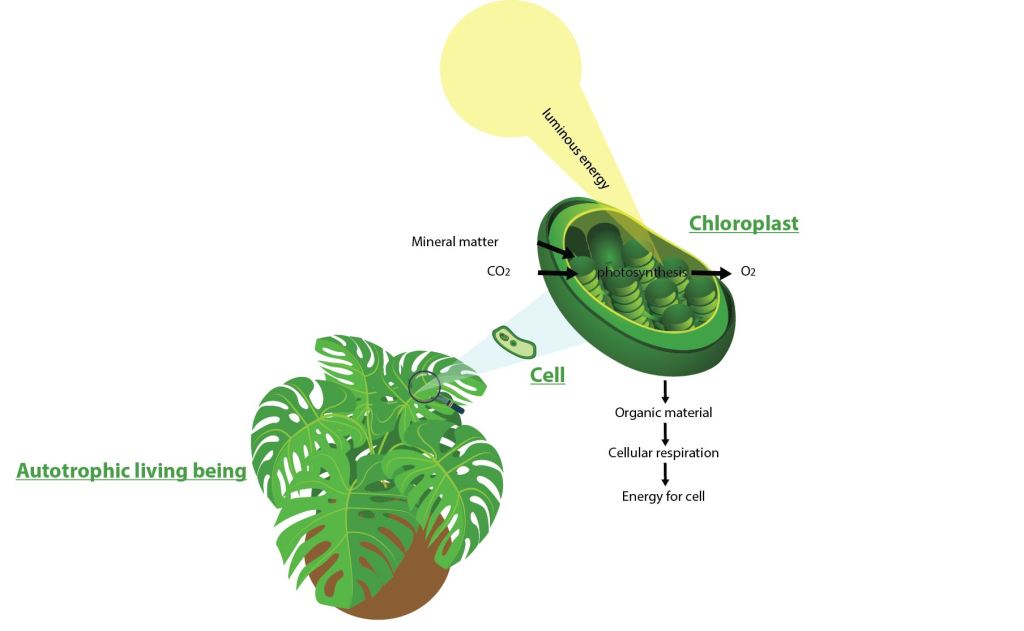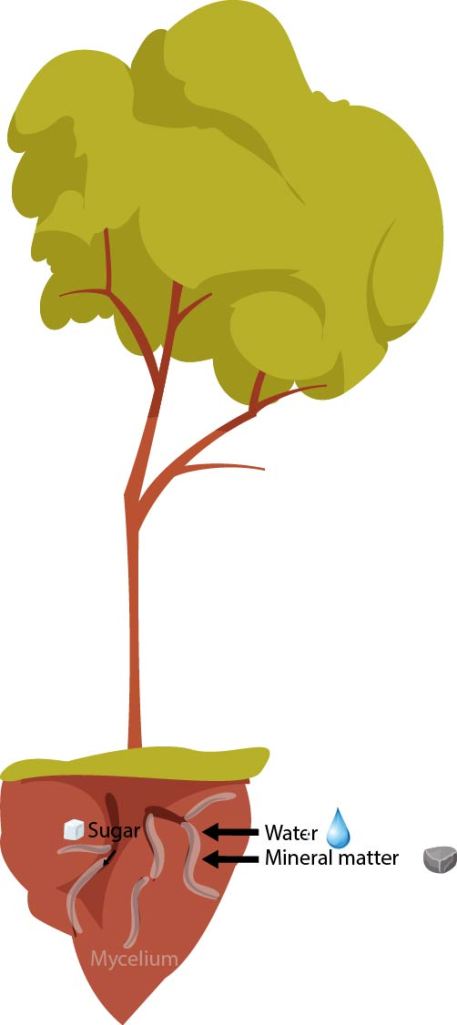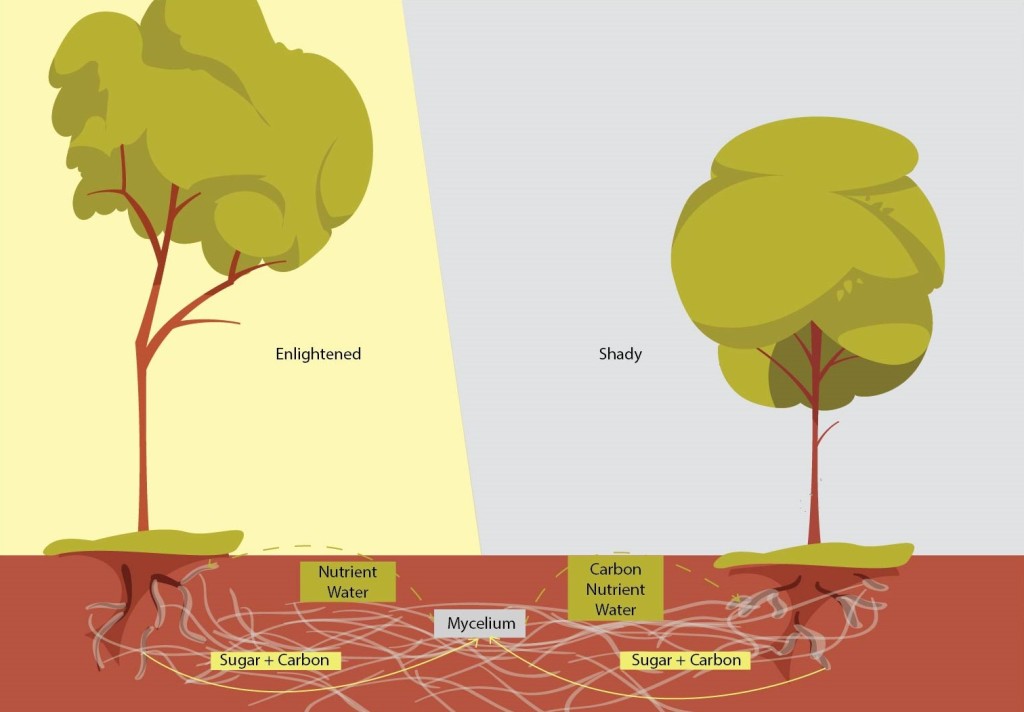Tree social networks
For a long time, we have imagined talking with trees and plants. We find examples in the most famous cartoons like Pocahontas exchanging with grandmother foliage or in the incredibly famous Lord of the rings.

So, of course, the trees do not speak to us directly, but they communicate with each other.
To better understand this, you must first understand how trees create their energy and feed.
Trees and plants are living things producing their own energy from light energy, carbon dioxide (CO2), dioxygen (O2) and mineral matter (an element found in the soil). They are said to be autotrophic.
This light energy is captured by an element in the cells of the plant, the chloroplasts. Elements giving this green color to plants and being at the origin of the photosynthesis mechanism. Photosynthesis is a plant mechanism known to produce organic matter which will then be used to produce its own energy for this plant. For photosynthesis to take place, it is necessary for the plant to capture light energy from its chloroplasts, mineral matter and CO2. This will then release in exchange into the air of O2, the same that allows us to breathe. Then the organic matter will be produced by a second mechanism called cellular respiration which will produce the energy necessary for the plant.
But the process does not stop there! We have seen that to carry out photosynthesis, the plant needs mineral matter. This comes from the ground and is captured by the roots through a symbiosis (association of two or more living beings, mutually beneficial, even essential to their survival) with a fungus called mycelium.
This fungus living at the root level is present in 80% of land plant species. It captures water and minerals to exchange it for the sugar produced by the plant during photosynthesis. The extent of the mycelium is very large and connects several plants of the same or different species. It can also integrate other mushroom networks, creating a real social network.
It is therefore through these mushroom networks that trees and other plants communicate. Several types of signals are used. Biochemical signals, transfer of resources, such as carbon, water, sugar …, or electrical signals. These transfers are made according to a certain gradient of necessity. This means that the elements transferred from one tree to another are dosed. This communication becomes visible to us, human beings, especially when we observe changes in morphology or physiology in response to the environment including the chemical, light, water … The best-known example being the change of orientation of the plant to optimize its exposure to the sun. In this specific case, faced with a situation, the plant changes its behavior.
When the plant or tree belongs to this network that we described earlier and they need to communicate with their peers, the information and the change in behavior of the group is very quick. This change in behavior will depend on the quantity and quality of the element transmitted. All this will also have an impact on the surrounding ecology, but also on the relationships between the same species of trees or not.
Thanks to teams of researchers, this phenomenon of communication between plants is now well studied. We find, for example, a « war » that took place between two species of pine in North America. Lodgepole pine having been eradicated by ponderosa pine. Following this extermination, scientists noticed a significant change in the electromagnetic fields in this area.
Another case of extermination was studied with the Black Walmut which eliminates all the neighbors not being part of the same species as him.
While plants attack, others defend themselves when attacked. This is the recognized case for tomatoes and potatoes. When their leaves are taken by a predator, the plant will send a signal to all its neighbors warning them of the danger. The plants will then react by making their leaves unfit for consumption.
We also find in nature collaborations with tree “parents” helping their children by transmitting to them, via networks, the sugar and elements necessary for their good and rapid development.
In the Amazon, another mutual aid has been studied. The very dense forest shelters large trees constituting the canopy, These will have an easier time doing photosynthesis. These large trees will then come to help those who do not have enough light to carry out their photosynthesis and have the elements necessary for their proper development. The trees of the canopy, transmit the missing elements to its disadvantaged plants via these networks of mycelium.
Plants can be compared to a large, even organism speaking and exchanging information and nutrients. They can help each other as well as go to war. In the end, their communication networks, which can extend over very long distances, strongly resemble our Internet, which next door seems very young.
If you are interested by the subject, you and you wish to develop it I recommend the excellent TEDx conference by researcher Suzanne W. Simard
https://www.youtube.com/watch?v=Un2yBgIAxYs&feature=youtu.be
References :
1. Monika A. Gorzelak et al. Inter-plant communication through mycorrhizal networks mediates complex adaptive behaviour in plant communities. AoB Plants. 2015.
2. Manuela Giovannetti et al. At the root of the wood wide web. Plant Signaling & Behavior. 2006.
3. Minxia Liang et al. Soil fungal networks maintain local dominance of ectomycorrhizal trees. Nature Communications. 2020.
4. Alessandra Pepe. Lifespan and functionality of mycorrhizal fungal mycelium are uncoupled from host plant lifespan. Scientific Reports. 2018.
5. Suzanne W. Simard. Mycorrhizal Networks Facilitate Tree Communication, Learning, and Memory. Memory and Learning in Plants. 2018.
6. Silvio Waisbord. Family Tree of Theories, Methodologies, and Strategies in Development Communication.2020.
7. https://www.youtube.com/watch?v=yWOqeyPIVRo
Comment ( 0 ) :
Subscribe to our newsletter
We post content regularly, stay up to date by subscribing to our newsletter.


